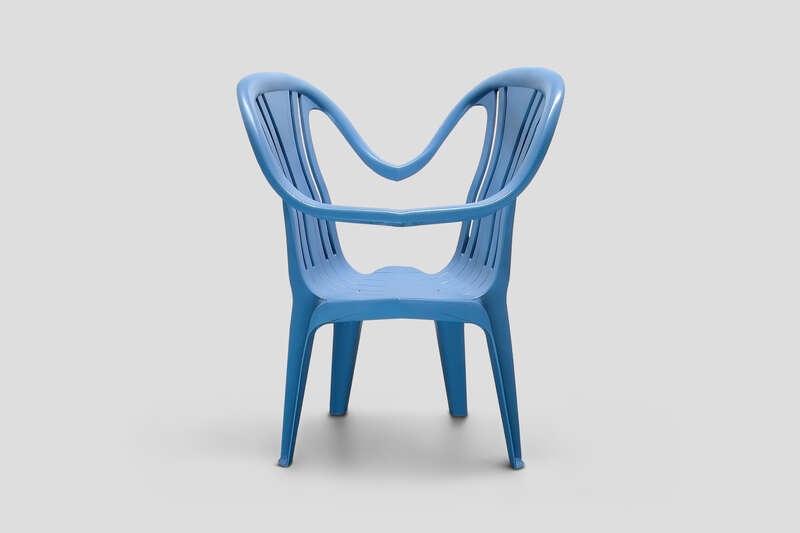Home > Advanced search > Objects > Mirror Chair No. 1
Mirror Chair No. 1
Kai Linke
2009
Frankfurt-based designer Kai Linke bases his design on the properties of the material: Is it castable, pliable, or solid? Reflective, opaque, or translucent? His designs often point beyond function to the semantic character of things—like this Mirror Chair No. 1, which can be understood more as a commentary than a utilitarian object. Created from two fused Monobloc plastic chairs, it clearly shows its origins as a chair, but no longer functions as such because it obviously prevents the user from sitting down on the seat. At the same time, it seems as if two pieces of furniture are holding hands or mirroring each other’s existence as chairs.
Title
Mirror Chair No. 1
Involved in the execution
Date
2009 (Production)
Geographical reference
Place of production: Frankfurt am Main
Material / Technique
Plastic
Dimensions
Overall:
89 × 62 × 73 cm
Object type
Collection
Inventory number
19339
Creditline
Museum Angewandte Kunst, Frankfurt am Main
Accession
Acquisition; 13.06.2023; Studio Kai Linke, Frankfurt am Main
Included in these topics
- Key: ea5ded53-f777-41ed-a2a3-2d8d43d97eb5
- Module_ref: collection
- Create_date: 2023-07-18T12:44:02Z
- Change_date: 2025-07-15T22:00:00Z
- Sync_date: 2025-12-07T21:47:54Z
- Container_S: Design
- InventoryNumber_S: 19339
- InventoryNumber_S_sort: 19339
- SimpleSearch: 19339,2009,Plastic,Studio Kai Linke, Frankfurt am Main,Found objects, Blue,Kai,Linke,Objects,Mirror Chair No. 1,Mirror Chair No. 1,Europe/Germany/Hesse/Frankfurt am Main,Europe;;Germany;;Hesse;;Frankfurt am Main,Modelling,Cutting (shaping or dividing),Bending,Linke,Kai,Linke, Kai,Offenbach,Frankfurt-based designer Kai Linke bases his design on the properties of the material: Is it castable, pliable, or solid? Reflective, opaque, or translucent? His designs often point beyond function to the semantic character of things—like this <em>Mirror Chair No. 1</em>, which can be understood more as a commentary than a utilitarian object. Created from two fused Monobloc plastic chairs, it clearly shows its origins as a chair, but no longer functions as such because it obviously prevents the user from sitting down on the seat. At the same time, it seems as if two pieces of furniture are holding hands or mirroring each other’s existence as chairs.,Plastik bestehend aus zwei verformten und miteinander verschmolzenen Monobloc-Gartenstüheln.
- SimpleSearch2: 19339,2009,Plastic,Studio Kai Linke, Frankfurt am Main,Found objects, Blue,Kai,Linke,Objects,Mirror Chair No. 1,Mirror Chair No. 1,Europe/Germany/Hesse/Frankfurt am Main,Europe;;Germany;;Hesse;;Frankfurt am Main,Modelling,Cutting (shaping or dividing),Bending,Linke,Kai,Linke, Kai,Offenbach,Frankfurt-based designer Kai Linke bases his design on the properties of the material: Is it castable, pliable, or solid? Reflective, opaque, or translucent? His designs often point beyond function to the semantic character of things—like this <em>Mirror Chair No. 1</em>, which can be understood more as a commentary than a utilitarian object. Created from two fused Monobloc plastic chairs, it clearly shows its origins as a chair, but no longer functions as such because it obviously prevents the user from sitting down on the seat. At the same time, it seems as if two pieces of furniture are holding hands or mirroring each other’s existence as chairs.,Plastik bestehend aus zwei verformten und miteinander verschmolzenen Monobloc-Gartenstüheln.
- InventoryNumberSearch_S: 19339
- IvNO_S: 19339
- AcquisitionDate_S: 13.06.2023
- MainTitle_S: Mirror Chair No. 1
- MainTitle_S_sort: Mirror Chair No. 1
- DatingType_S: Herstellung | Production
- Dating_S: 2009
- Dating_S2: 2009
- YearFrom_I: 2009
- YearTo_I: 2009
- Copyright_S: © Kai Linke
- Creditline_S: Museum Angewandte Kunst, Frankfurt am Main
- Systematic_S: Design
- Systematic_multi_facet: Design
- Systematic_multi_facet_filter: Design
- MaterialTechnique_S: Plastic
- AcquisitionType_S: Acquisition
- AcquisitionFrom_S: Studio Kai Linke, Frankfurt am Main
- Keywords_S: Found objects, Blue
- Keywords_multi_facet: Found objects;;Blue
- Keywords_multi_facet_filter: Found objects;;Blue
- Techniques_multi_facet: Modelling;;Cutting (shaping or dividing);;Bending
- Techniques_multi_facet_filter: Modelling;;Cutting (shaping or dividing);;Bending
- Subjects_FirstName_multi_facet: Kai
- Subjects_FirstName_multi_facet_filter: Kai
- Subjects_Name_multi_facet: Linke
- Subjects_Name_multi_facet_filter: Linke
- Subjects_FullName_multi_facet: Kai Linke
- Subjects_FullName_multi_facet_filter: Kai Linke
- Subjects_NameSorted_multi_facet: Linke, Kai
- Subjects_NameSorted_multi_facet_filter: Linke, Kai
- lists_s: ObjectNames,Titles,GeographicReferences,Materials,Techniques,Datings,Subjects,Texts,Dimensions,WebLinks,Media
- list_ObjectNames_I: 1
- ObjectNames_Type_0_S: Obj.bez.
- ObjectNames_Text_0_S: Objects
- list_Titles_I: 2
- Titles_Type_0_S: Titel
- Titles_Text_0_S: Mirror Chair No. 1
- Titles_Text_S_sort: Mirror Chair No. 1
- TitleSearch: Mirror Chair No. 1,Mirror Chair No. 1
- Titles_Type_1_S: Titel (englisch)
- Titles_Text_1_S: Mirror Chair No. 1
- list_GeographicReferences_I: 1
- GeographicReferences_Type_0_S: Herstellungsort | Place of production
- GeographicReferences_Text_0_S: Europe/Germany/Hesse/Frankfurt am Main
- GeographicReferences_Text_0_multi_facet: Europe;;Germany;;Hesse;;Frankfurt am Main
- GeographicReferences_Text_0_multi_facet_filter: Europe;;Germany;;Hesse;;Frankfurt am Main
- list_Materials_I: 0
- list_Techniques_I: 3
- Techniques_Type_0_S: Technik
- Techniques_Text_0_S: Modelling
- Techniques_Type_1_S: Technik
- Techniques_Text_1_S: Cutting (shaping or dividing)
- Techniques_Type_2_S: Technik
- Techniques_Text_2_S: Bending
- list_Datings_I: 0
- list_Subjects_I: 1
- Subjects_Role_0_S: Design
- Subjects_Key_0_S: 68c9e667-bd1a-42ef-bfad-1fdb35da403d
- Subjects_Type_0_S: Person
- Subjects_Name_0_S: Linke
- Subjects_FirstName_0_S: Kai
- Subjects_SortedName_0_S: Linke, Kai
- Subjects_S_sort: Linke, Kai
- Subjects_Dating_0_S: 1980-
- Subjects_PlaceOfBirth_0_S: Offenbach
- Subjects_UriGnd_0_S: http://d-nb.info/gnd/1211113884
- list_Texts_I: 1
- Texts_Type_0_S: Web (englisch)
- Texts_Language_0_S: EN
- Texts_LongText_0_S: Frankfurt-based designer Kai Linke bases his design on the properties of the material: Is it castable, pliable, or solid? Reflective, opaque, or translucent? His designs often point beyond function to the semantic character of things—like this <em>Mirror Chair No. 1</em>, which can be understood more as a commentary than a utilitarian object. Created from two fused Monobloc plastic chairs, it clearly shows its origins as a chair, but no longer functions as such because it obviously prevents the user from sitting down on the seat. At the same time, it seems as if two pieces of furniture are holding hands or mirroring each other’s existence as chairs.
- list_Dimensions_I: 1
- Dimensions_Type_0_S: Objektmaß | Overall
- Dimensions_Dimension_0_S: 89 x 62 x 73 cm
- list_WebLinks_I: 0
- list_Media_I: 1
- Media_Key_0_s: 18d6c827-d3a9-4460-b9d6-deed025ae5fd
- Media_Type_0_S: Bild
- Media_AltText_0_S: Plastik bestehend aus zwei verformten und miteinander verschmolzenen Monobloc-Gartenstüheln.
- Media_Rightsholder_0_S: Museum Angewandte Kunst
- Media_Credits_0_S: © Studio Kai Linke
- _version_: 1850888516471357400
- lists: [object Object]




